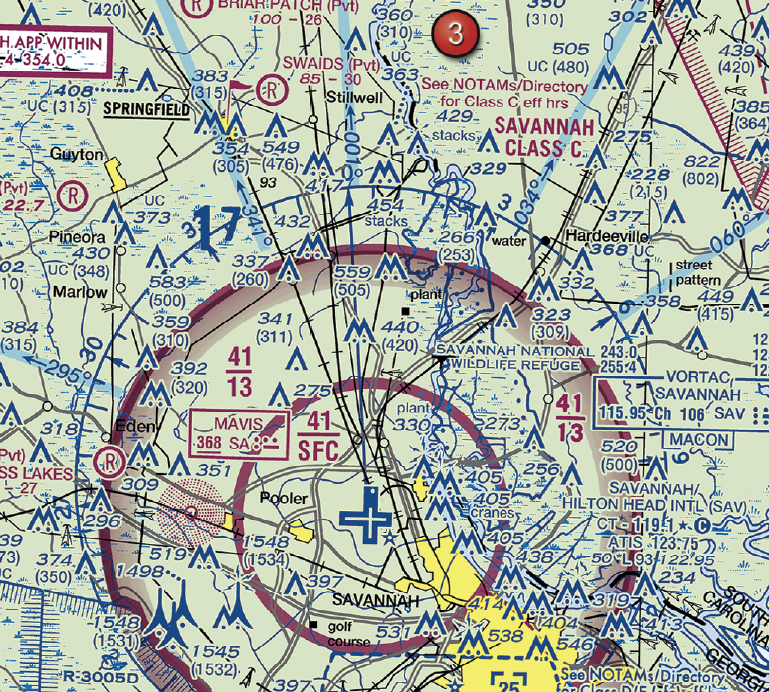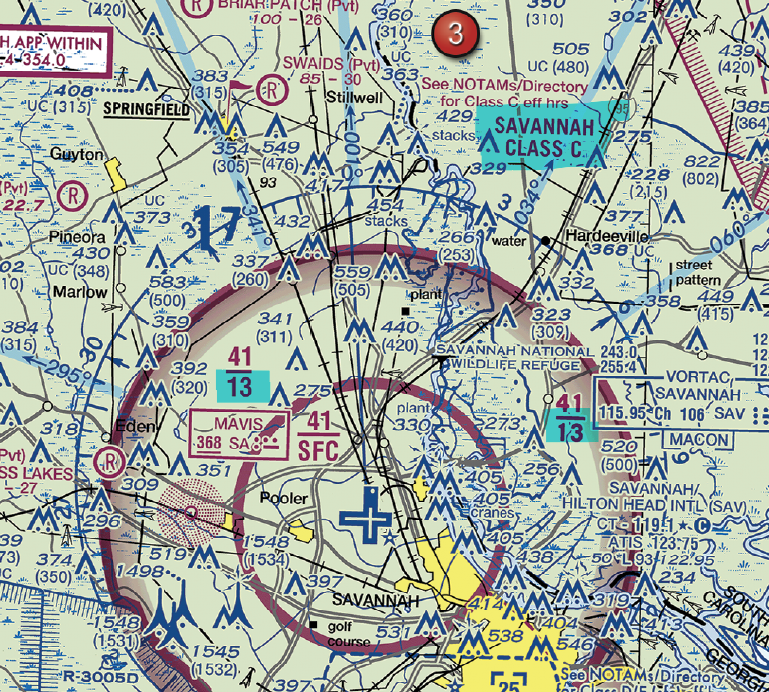Study(Refer to FAA-CT-8080-2H, Figure 23, area 3.) What is the floor of the Savannah Class C airspace at the shelf area (outer circle)?
- ❌A:1,300 feet AGL.
- ✅B:1,300 feet MSL.
- ❌C:1,700 feet MSL.

FAA-CT-8080-2H Figure 23 Area 3 - Click to enlarge.
Answer Figure

Click to enlarge answer figure
Explanations
- A: Incorrect. AGL (Above Ground Level) refers to the height above the immediate ground surface, but Class C airspace boundaries on sectional charts are defined using MSL (Mean Sea Level) values. Misunderstanding this could lead to safety risks such as collision and damage, regulatory violations, and potential business disruptions.
- B: Correct. The label '41/13' on the chart indicates a ceiling of 4,100 feet MSL and a floor of 1,300 feet MSL for the shelf area. Understanding this is crucial to maintaining safety, regulatory compliance, and efficient business operations in controlled airspace.
- C: Incorrect. While some Class C shelves begin at 1,700 MSL, Savannah’s outer ring is clearly labeled with a floor of 1,300 feet MSL. Misinterpretation can lead to safety hazards, regulatory penalties, and potential loss of business reputation.
🧭 Instructor Note
Why This Matters for Your Business
Understanding the structure of Class C airspace is crucial for operating a drone business. Misinterpretation of altitude limits can lead to safety risks, regulatory violations, and potential damage to your business reputation.
Safety & Liability Considerations
Operating at incorrect altitudes can lead to collision risks with other aircraft, damage to property, and potential injury to people on the ground. It's also essential to maintain regulatory compliance to avoid fines and legal issues.
Consider This Scenario
A real estate company hires a drone operator to capture aerial footage of a property located near the Savannah Class C airspace. The operator must understand the floor and ceiling limits of the airspace to ensure safe and legal operation. Misinterpreting the '41/13' label could lead to flying at an incorrect altitude, posing safety risks and potential regulatory violations.
What the FAA is Testing
The FAA wants to ensure that drone operators understand how to interpret sectional charts, particularly the altitude limits of controlled airspace. Misinterpretation can lead to safety hazards and regulatory penalties.
Business Success Strategy
Ensure that all drone operators in your business are trained to interpret sectional charts accurately. Regularly review airspace classifications and altitude limits as part of your safety and compliance training.
Memory Aid
Airspace labeled '41/13' means a ceiling of 4,100 feet MSL and a floor of 1,300 feet MSL. Confirm MSL/AGL. Usually "in the air" measurements will be MSL (above the oceans) and "from the ground" heights, etc. will be AGL.
Enhanced References
FAA Aeronautical Chart User's Guide, Sectional Charts, ACS UA.II.A.K1b
Related Concepts
- Class C airspace structure: Surface area and shelf area are defined using MSL altitudes.
- Chart annotation: The '41/13' indicates 4,100 MSL ceiling and 1,300 MSL floor.
- MSL vs. AGL: Understanding the altitude reference system is essential for interpreting sectional charts.
ACS Code: UA.II.A.K1b
Difficulty: basic
